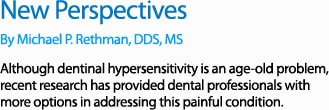
New Perspectives
We all share the common desire of a functional, comfortable, and esthetic mouth and dentition.

Experienced oral health care professionals know that satisfying patients’ individual goals may necessitate incremental treatment steps, and that these steps can be challenging. There may be more than one way to approach each step in a treatment plan, and conditions that don’t respond well to one strategy may respond to another. Finally, we know that even the so-called best treatments for some oral health problems may be less than ideal for an individual patient, especially when it comes to chronic problems such as dentinal hypersensitivity.
PAIN RELIEF
Among the patient-centered motivations for dental care, relief of pain is arguably the most compelling. Pain is considered a psychological response to certain stimuli. It seems that each person is variably “programmed” to recognize a specific stimulus as pain, mediated by a unique mix of gene expression and life experiences. Keep in mind that stimuli may cause pain on a highly individualized basis and that pain invariably includes psychological components.
For centuries, the practice of dentistry involved the removal (often by barbers) of teeth considered painful or infected. In early America, barbers who could extract teeth while minimizing intraoperative pain often found themselves quite busy providing dental services. Such an oral care “delivery system” remained commonplace—even in parts of advanced nations—into the early 20th century. This said, it should come as no surprise that up to even a few decades ago, treatments for dentinal hypersensitivity were nascent, speculative, and unproven.
Gradually, an emerging “I want to save my teeth” mindset among baby-boomers and subsequent generations, in addition to greater societal wealth, resulted in prodigious advancements in clinical dentistry. In the final third of the 20th century, the need for better treatments for dentinal hypersensitivity also came to the fore. Only over the past several decades have researchers, clinicians, and manufacturers developed etiological concepts, improved preventive practices, and devised treatments for dentinal hypersensitivity that are both reasonably effective and predictable.
WHAT’S TO COME
Contemporary dental practitioners need to prevent the onset of dentinal hypersensitivity whenever possible, adequately assess and treat it when it occurs, continue to monitor sites that are prone to dentinal hypersensitivity, and avoid causing new outbreaks. In addition, they should modulate sensitivity therapy based on responses to previous care, as well as new knowledge that emerges. This educational supplement conveys important information regarding the definition, prevalence, pathophysiology, diagnosis, and management of dentinal hypersensitivity. The first article discusses the pathophysiology and diagnosis of dentinal hypersensitivity, while the second piece looks at therapeutic approaches and treatment planning. We hope you find them helpful.
From Dimensions of Dental Hygiene. September 2011 Supplement; 9(9): 53.

